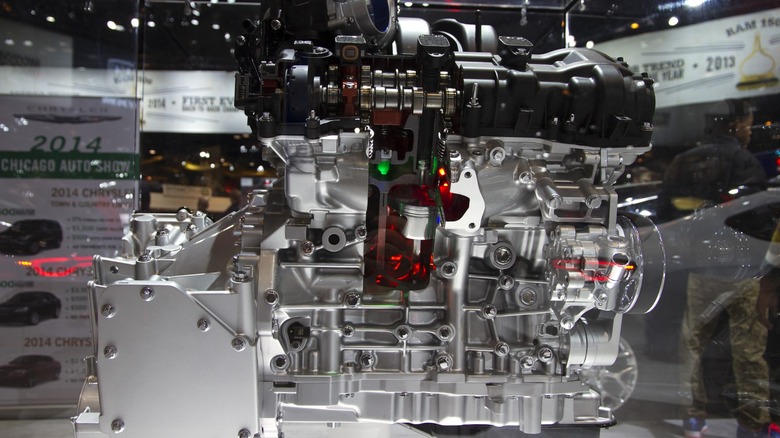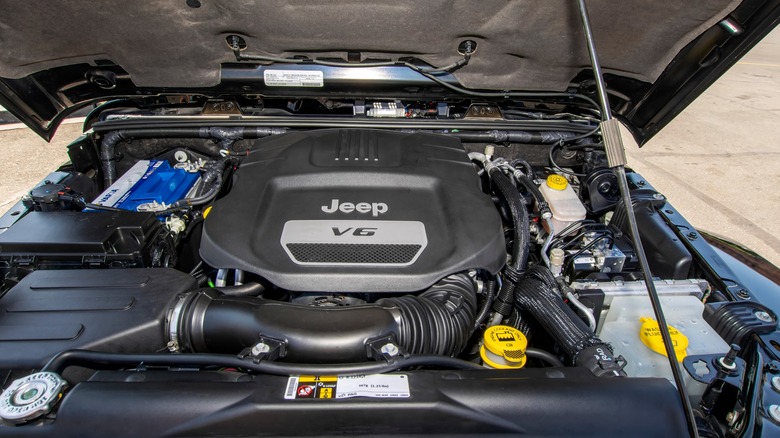
Boykov/Shutterstock
The Pentastar 3.6-liter V6 engine is found in a ton of different vehicles across the Stellantis lineup. From the expected Dodge and Jeep offerings to Lancia and Fiat models never released in the United States, it’s a widespread engine platform that seems to be aging decently well. It was first introduced at the New York Auto Show in 2009 and made its first appearance in production Chrysler, Dodge, and Jeep vehicles for the 2011 model year. Since then, it has continued production to the present day.
While the engine is largely reliable when well taken care of, it does have a few small hiccups to look out for. Nothing is perfect, but as long as you proceed with caution and take good care of your Pentastar-powered Jeep, it will take good care of you. Let’s take a look at the specs and what common problems you might run into as a Pentastar 3.6 owner.
Pentastar 3.6L V6 Specs and Tech Info
The Pentastar V6 features a high-pressure aluminum die-cast engine block with a 60-degree V angle. It uses an open deck design to save weight and reduce production costs. However, the cylinder liners are cast iron and quite sturdy. This, combined with piston-cooling oil jets, small piston skirt area, low-friction rings, and lightweight aluminum pistons, makes for a light, efficient, and durable design.
The Pentastar V6 has between 283 and 305 horsepower, depending on its model. With 90% of maximum torque achieved in the range of 1,800 to 6,350 RPM, its broad powerband ensures near-instant pickup and sustained, consistent power throughout the rev range.
Pentastar V6s from 2016 and newer, like those in the Jeep Grand Cherokee and Jeep Gladiator, saw a few upgrades compared to earlier variants. They have variable valve lift systems to increase fuel economy, a plastic intake manifold with longer runners, improved valve springs, and a higher compression ratio.
Common 3.6L Jeep V6 Engine Issues

Artem Avetisyan/Shutterstock
Nothing is without fault. While the Pentastar V6 is largely reliable, there are some things to keep an eye on.
Some Pentastar V6 engines are prone to rocker arm failure. If you hear a ticking or tapping sound from the engine’s top end or you have a misfire, this could be your issue. This may also cause a check engine light with a diagnostic code indicating a misfire. FCA addressed this issue with a technical service bulletin for repair in March of 2014, but some newer Pentastar engines are still experiencing this failure.
If the ticking sound isn’t from a failing rocker arm, though, it could be far worse. Some Pentastar V6 engines experience all-out cylinder head failure. The left-side cylinder head on 0.5% of 2011 through 2013 model-year vehicles was subject to premature and excessive wear. FCA revised the cylinder heads to include hardened valve guides and seats in 2012. Since then, this issue has been very uncommon.
Finally, some Pentastar engines experienced failures from sand-casting production remnants that can clog radiators, water pumps, and even oil pumps. Unfortunately, this can cause complete destruction of the engine. However, it is not a commonly reported issue.
Overall, with over 10 million Pentastar 3.6-liter V6 engines having been produced, it’s safe to say the failure numbers are pretty minimal compared to the production numbers. As with any engine, take good care of it, and it will take good care of you.